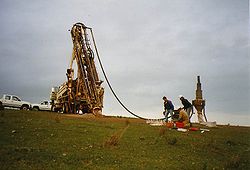Mineral exploration
In mining and geology, exploration refers to the search for or development (precise investigation) of deposits and raw material deposits in the earth's crust. Exploration geology is a subfield of deposit science within the geosciences.
Historically, exploration can be considered one of the essential precursors of geological research, as a variety of mineral resources have been more or less systematically developed and exploited for several thousand years. An example of this are coal deposits that have come to light freely, which were exploited very early in the history of mankind.
The main areas of exploration geology are deposits and occurrences of:
- Oil and gas
- Coal
- Ore
- Geothermal
- Water
From a methodological point of view, groundwater exploration can also be regarded as a task of exploration geology, since it is also a natural (albeit mostly renewable) resource.
In the course of the exploration of a deposit, the exploration phase follows the prospecting phase. In this phase, initially only an area of aperture was identified, which justified further investigations. Now the actual development begins with the delineation of the localized deposit. The geological framework is now known, and the risk of the previous investment and work being wasted is now only about 50%. The investigations started during the prospecting (geological mapping, sampling in trenches and drillings, chemical and mineralogical-petrographic analyses) will be systematically continued and extended. At the end of this phase, it should be possible to estimate the dimensions of the deposit, as well as a first calculation of the reserves. On the basis of these data it has to be decided whether the further development of the deposit is reasonable or not.
Exploration geologists have a wide range of scientific methods at their disposal for this purpose, in which almost all geological sciences are applied
- geophysical methods (gravimetry, geoseismics, geomagnetics, geoelectrics, borehole geophysics, etc.)
- tectonic and structural geological analyses
- palaeontological analyses (e.g. stratification of drill cores)
- geochemical analysis for the determination of enrichment values
- Geoinformatics (tectonic analyses, development of exploitation strategies and visualization)
The deposit is now proven. The exploration work is supplemented with technical tests (testing of metallurgical processing, sometimes experimental mining) and reaches its preliminary conclusion with the feasibility study. The entire exploration of a deposit is expected to take between five and ten years. If the feasibility study prepared in the context of mining economics is positive, actual mining can begin. In parallel, exploration continues in the less known parts of the deposit.
In addition to the exploitation of deposits, exploration geologists are now increasingly used in the processing of environmental damage, as the scientific work in environmental geology is similar to that in exploration geology.

A mobile drilling rig on a truck is used to drill the first test wells in a new area of acreage. In this case, only crushed rock samples ("chips") are obtained instead of the (expensive) drill cores. At the "cyclone" (right in the picture) they are examined and packed.
Ores
| Mineral / Metal | Digestion colour | Minerals in the outcrop |
| Iron sulfides | Yellow, Brown, Red | Goethite, hematite, limonite, iron sulfates |
| Manganese | Black | Manganese Oxides |
| Antimony | White | Antimony Bloom |
| Arsenic | Greenish, Yellowish | Ferrous arsenate |
| Bismuth | Light yellow | Bismuth ochre |
| Cadmium | Light yellow | Cadmium sulfide |
| Cobalt | Black, Purple | Erythrin, cobalt oxides |
| Copper | Green, Blue | Copper minerals |
| Lead | White, Yellow | Cerussite, Anglesite, Pyromorphite |
| Mercury | Red | Cinnabar |
| Molybdenum | Light yellow | Molybdenum oxides, iron molybdate |
| Nickel | Green | Annabergite, Garnierite |
| Silver | Green, Yellow | solid silver |
| Uranium | Light green, yellow | Torbernite, Autunite |
| Vanadium | Green, Yellow | Vanadate |
| Zinc | White | Zinc spar |
See also
- Unbalance bore
Search within the encyclopedia